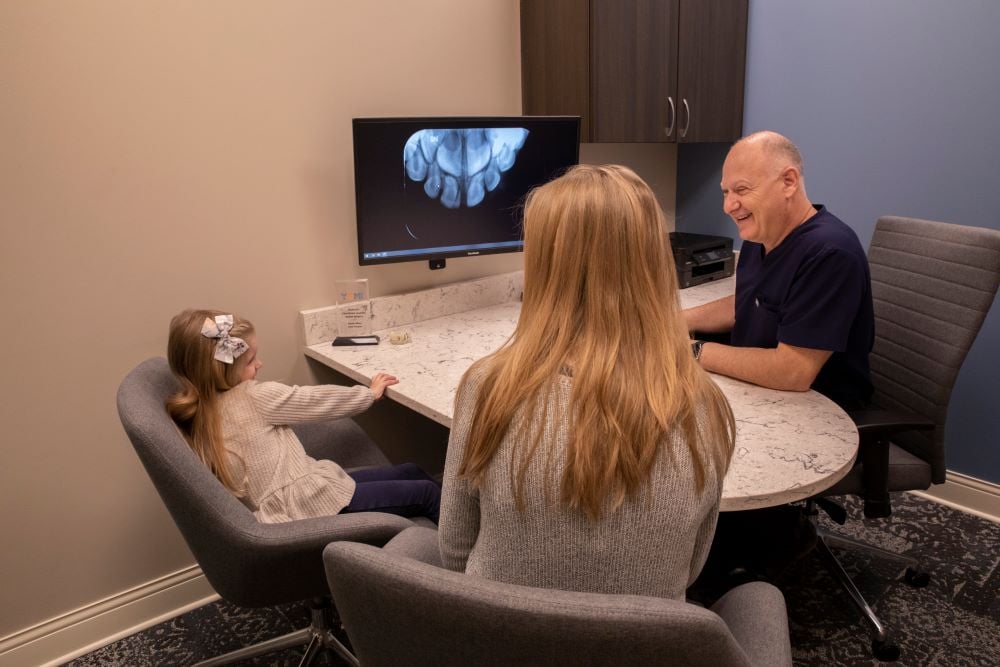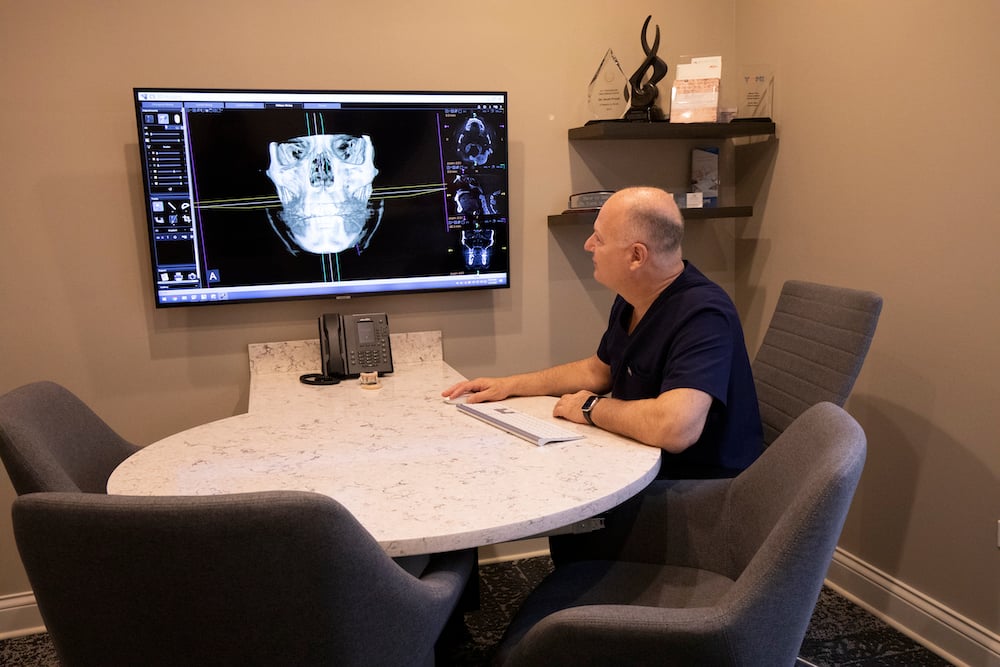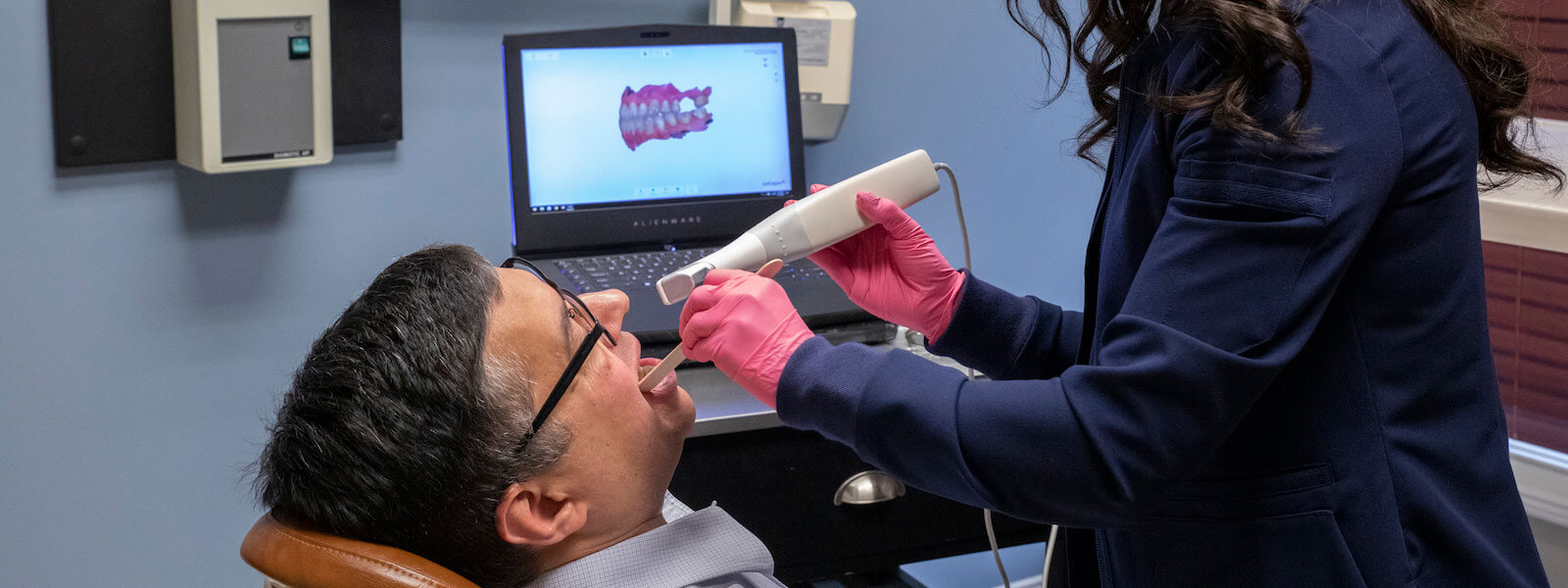advantages of virtual surgery
The X-rays and digital impressions combined together in a specially designed software program enable dentists to view a clear and detailed picture of the patient’s teeth, gums, bone and jaw all at once. They can see the inside and outside structures of the teeth, as well as all the surrounding structures, on a computer screen.
This is the point where the knowledge and skill of the dentist and dental surgeon come into play as they use the software to design the treatment plan in detail, step-by-step, including both creating the ideal tooth restoration and plotting out the ideal implant placement to best fit the mouth structure and bite of the patient, while avoiding potential problem areas such as nerves and sinuses.
.jpg?width=1000&name=D87A5576%20(1).jpg)
The 3D imagery makes it much easier for the oral surgeon to see, in advance, any potential problems in implementing the implant treatment procedure. For example, the software images enable the oral surgeon to see if bone grafts are needed before placing implants.
Using the digital imagery with the computer software program, the oral surgeon creates a virtual surgery plan designed to achieve the best possible outcome in both practical functionality and in terms of getting the best possible cosmetic look for the patient.

Advantages of 3D printers
Once the virtual surgery design has been created, we can then transfer that information to patient's mouth in the form of a surgical guide that’s created with a 3D printer. With the 3D printer guide image, the dentist or surgeon can essentially overlay a blueprint of the surgery plan inside the patient’s mouth. Obviously, having a clear surgical guide like that right in front of them as they’re doing to the surgery enables the dental surgeon to work much more quickly and accurately. Being able to produce a 3D surgical guide offers tremendous advantages for obtaining the ideal outcome.
The digital surgery images can also significantly shorten the total treatment time frame for getting implants. For example, ordinarily, if a patient has to have a tooth extracted, then the dentist has to allow three to four months of healing and recovery after that, plus another three to four months after placing the implant before the restoration is installed. But with the 3D digital technology, because the virtual surgery map allows for clear visualization of the bone shape and size, it greatly increases the chance that the tooth extraction can be followed by an immediate implant placement. That makes for a much shorter healing time and therefore a shorter overall treatment time.
We recently completed a case in which the patient went from tooth extraction – followed by immediate implant placement - to final restoration in just 10 weeks. So that was all done in less than three months’ time, as opposed to the total treatment time of seven to nine months that’s usually required when an oral surgeon is using the older, traditional “analog” implant dentistry techniques.

Having the benefits of 3D imagery and printouts means fewer appointments, less pain and shorter recovery time for the patient. It usually also means less actual surgery is required, since using the 3D surgical guide allows a more precise surgery, where the surgeon doesn’t have to move as much tissue. Without the 3D imagery, the surgeon has to move more tissue in order to better see the exact surgical site. But with the 3D images, the surgeon can already see the whole surgical site very clearly without having to move tissue.
With digital implant dentistry, there is usually little, if any, tissue that needs to be moved to place a dental implant. And less actual surgery translates to less pain and swelling afterward, so again it helps make the whole process easier for the patient. We’ve had many patients say, following the surgery, that they were surprised by how easy the procedure seemed and how little discomfort they experienced afterward.
Using the surgery “map” produced using the 3D printer also offers the benefit of helping the surgeon to avoid any potential complications because the nerves, sinuses, bone shape, and contour can all be clearly seen on the virtual surgery guide.
All in all, using the latest digital technology is far superior to the traditional analog implant technique where a surgeon has to basically eyeball the surgical site and make the best possible guess as far implant placement. Digital implant dentistry is much more accurate, much safer, and leads to final results that are noticeably much better.
Digital dentistry is a major step forward in dental treatment therapies. If you are considering dental implants, or any other dental restoration therapy, talk with an oral surgeon who is trained and skilled in using this new technology.
If you're ready to take the next step and improve your oral health with the advanced dental technology that we have at our practice, get in touch today!
This blog post is based on an excerpt from Dr. Scott Frank's chapter in the book, "A Reason to Smile: Fixing Broken Confidence with Cosmetic Dentistry."



